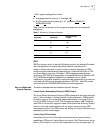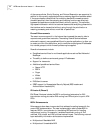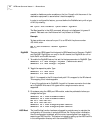
New Features Application Notes 19
WARNING: For network security, do not include security sensitive information
such as passwords. The ASCII text file is not encyrpted, which means the
passwords are readable by anyone who has access to the file.
When the router is booted and the BOOT.CFG file is detected in the configuration
directory, all existing configuration files (except CCSMACRO and IOXM) in the
configuration directory are deleted. The configuration commands in the
BOOT.CFG file are then executed. If a configuration command fails to execute
successfully, it does not stop, but continues with the next configuration command.
Just as when you enter a configuration command on the command line, new
encoded configuration files are created. As long as the file BOOT.CFG is detected
in the configuration directory, this operation is repeated every time the router is
rebooted.
To suspend this operation and use the encoded configuration files when the router
is rebooted, the BOOT.CFG file can be renamed (ReName command is now
supported by LoadConfigs) as the last command in the BOOT.CFG file.
To minimize the impact of executing configuration commands at boot time, the
configuration commands are not displayed. However, as with normal LoadConfigs
operations, a log file is created, which contains the configuration commands that
were executed along with any comments from the BOOT.CFG file and system
messages that may have been generated.
If the router has intelligent I/O modules (6 port Ethernet, ATM module, Multiport
BRI modules), they are loaded before any of the commands are executed. The
"System Initialized and Running" message is not displayed (that is, no user
interaction is possible) until after all of the commands in the BOOT.CFG file have
executed. If the ASCII boot feature has been invoked, a message appears as part
of the SysconF command Boot Statistics information to indicate this.
Configuration changes executed after the router is booted are not automatically
captured in the BOOT.CFG file and would be lost if the router was rebooted. Also,
the execution of the ASCII boot feature does not affect any macros that have been
defined or the SysconF configuration.
After booting with the boot.cfg file, any changes made to the device via telnet,
console, SNMP, or web interface are not saved to the boot.cfg file. It is
recommended that you make all changes in the boot.cfg file directly.


















